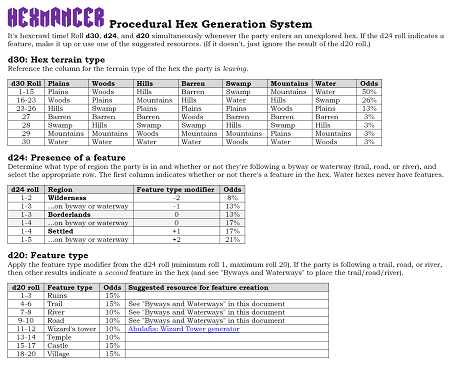I needed a simple system for procedurally generating hexcrawl terrain and features, so I made one: Hexmancer. It’s two pages long, including design notes and acknowledgements, and you get to roll funky dice.

What it does
Hexmancer hexcrawls with your hexes, baby!
Hexmancer is designed to procedurally generate a fantasy borderlands/wilderness region in “fantasy Western Europe,” with occasional wasteland and weirdness, on the fly during play. It assumes that you’re placing dungeons/modules and perhaps a feature or two, but otherwise starting out with the PCs in a village surrounded by a blank hex map.
This 1.0 version has been through multiple drafts and rewrites, but hasn’t yet been tested in play.
(Update: I’ve now written up an extended example using 12 actual Hexmancer rolls, and I took that opportunity to tidy up some of the language and update the PDF.))
Other stuff you’ll need
You’ll need five dice: d5, d6, d20, d24, and d30. (The excellent, and free, Purple Sorcerer dice roller includes funky dice.)
Hexmancer will generate terrain, tell you when features are present, and determine what those features are — but you’ll need to create the actual features.
The recommended resources section used to be more robust, but I edited it in February 2020 after the current owner of Judges Guild turned out to be a massive fucking asshat.
Acknowledgements
Hexmancer is based on the system found in Wilderness Hexplore Revised, which was created by Jedo of the New York Red Box forums. The core “Terrain > Feature? > Feature” mechanic and the broad relationships between terrain types in Hexmancer owe the most to Jedo’s system.
If you use Hexmancer, I’d love to hear how it went!

Pingback: Daily Snapshot – February 10, 2016 – OSR Today
Very cool. I have a copy of “Source of the Nile” which uses a procedural generation technique for generating terrain, in this case in Africa.
There is, or was in the original version, a “bug” in that hexes tended – by design – to be similar to the ones you had come from.
It was possible under certain circumstances for an evil explorer to walk from side to side on the map, “knitting” the same sort of terrain across vast swaths of Africa. Jungles could be cut by arrow-straight swaths of veldt or swamp and so forth.
Thanks for this article an the links from it. Most useful, and makes me want to run a blank hexsheet exploration campaign.
You bet! I hope you give that campaign a shot. :-)